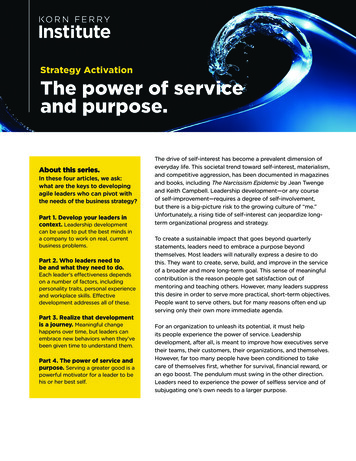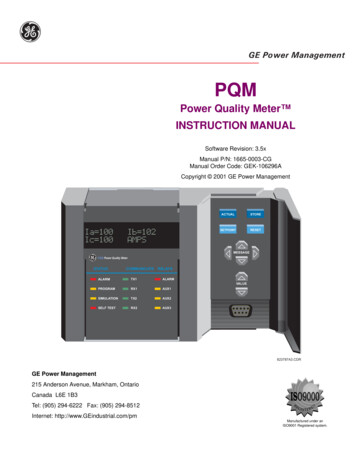
Transcription
Strategy ActivationThe power of serviceand purpose.About this series.In these four articles, we ask:what are the keys to developingagile leaders who can pivot withthe needs of the business strategy?Part 1. Develop your leaders incontext. Leadership developmentcan be used to put the best minds ina company to work on real, currentbusiness problems.Part 2. Who leaders need tobe and what they need to do.Each leader’s effectiveness dependson a number of factors, includingpersonality traits, personal experienceand workplace skills. Effectivedevelopment addresses all of these.Part 3. Realize that developmentis a journey. Meaningful changehappens over time, but leaders canembrace new behaviors when they’vebeen given time to understand them.Part 4. The power of service andpurpose. Serving a greater good is apowerful motivator for a leader to behis or her best self.The drive of self-interest has become a prevalent dimension ofeveryday life. This societal trend toward self-interest, materialism,and competitive aggression, has been documented in magazinesand books, including The Narcissism Epidemic by Jean Twengeand Keith Campbell. Leadership development—or any courseof self-improvement—requires a degree of self-involvement,but there is a big-picture risk to the growing culture of “me.”Unfortunately, a rising tide of self-interest can jeopardize longterm organizational progress and strategy.To create a sustainable impact that goes beyond quarterlystatements, leaders need to embrace a purpose beyondthemselves. Most leaders will naturally express a desire to dothis. They want to create, serve, build, and improve in the serviceof a broader and more long-term goal. This sense of meaningfulcontribution is the reason people get satisfaction out ofmentoring and teaching others. However, many leaders suppressthis desire in order to serve more practical, short-term objectives.People want to serve others, but for many reasons often end upserving only their own more immediate agenda.For an organization to unleash its potential, it must helpits people experience the power of service. Leadershipdevelopment, after all, is meant to improve how executives servetheir teams, their customers, their organizations, and themselves.However, far too many people have been conditioned to takecare of themselves first, whether for survival, financial reward, oran ego boost. The pendulum must swing in the other direction.Leaders need to experience the power of selfless service and ofsubjugating one’s own needs to a larger purpose.
When combined, purpose and service are the fuel for transformation. As Winston Churchill said,“If the human race wishes to have a prolonged and indefinite period of material prosperity, theyhave only got to behave in a peaceful and helpful way toward one another.” Service to others ismore than just a nice thing to do. It inspires deep, lasting change.If service is critical to leadership development, then the next question is how to provide leaderswith the opportunity to serve. It makes sense to capitalize on an organization’s existing (orevolving) service platform. The following cases describe how three organizations put service atthe center of their leadership models.Community service as a path to leadership growth.Most organizations donate financially to any number of worthy causes. Sometimes these causesalign with a core business. Food companies address hunger. Engineering organizations targetinfrastructure or water. Financial institutions support community development. Many companies,however, simply donate funds to a clearinghouse that channels their money to groups in needof support. There is nothing wrong with this, but it is a missed opportunity for leadershipdevelopment. It also does not create an emotional connection between employees and the cause.Exelis, an aerospace and defense company, takes a more focused approach to community service.CEO David Melcher says, “I would advise anyone to try to find a cause that your employeescan feel connected to.” Through its Exelis Action Corps (EAC), the company uses the skillsof employees to serve members of the military, veterans, and their families. EAC also trainsemployees to organize and lead volunteer efforts.Although financial giving is part of EAC’s philanthropic strategy, italso aims to create sustainable programs in the veterans community.“We emphasize those things here because, at the end of the day, itmakes for a better employee and a better company,” Melcher explains.Exelis employees are encouraged to give their time and talents tosponsored projects. They are also trained to lead projects and takeinitiatives into their local communities. Not only are they volunteering,they are also leading. Additionally, Exelis incorporates EAC projectsinto its formal leadership development and high potential programs.This delivers the message that service is a critical part of the overallleadership model. “I guess service leadership, to me, means being awhole person and understanding that it’s about your work life, yourpersonal life, your family life, your social life, [and] your philanthropiclife,” Melcher says. “All those things have to come together in a waythat makes sense and is balanced.”Key lessons from Exelis:1. Align community serviceto organization strategy.2. Use the service platformto develop future leaders.3. Deploy in-demandskills (and resources) tosupport the community.4. Make service explicitlyimportant and provideemployees opportunitiesto serve and learn.
Service over self.Service leadership is, first and foremost, about putting aside personal concerns to prioritize the needsof others. As Nelson Ford, president and CEO of LMI Government Consulting, says, “The desire tohelp other people accomplish something is how I define [it]. It’s not about me; it’s about what we canaccomplish together. I think that’s what maybe distinguishes leadership from service leadership.”Ford points out that the workforce at LMI comes largely from a service background. Most employees are from the military, civil service, and/or the nonprofit sector. Because of this, service is part of LMI’s organizational makeup.However, even nonprofit organizations are not automatically geared togive back to the community. It’s up to leadership to promote the notionof service first. LMI has a mission of “improving the management ofgovernment” and tries to help employees act on a desire to serve thecommunity. The company emphasizes the meaning and value of that serviceas opposed to the bottom line. Ford says, “One of the things we’re goingto do is take our external engagement—our charity activity, our academicpartnerships—and we’re going to make it much more a focal point of whatwe do so that everybody gets the connection.”Key lessons from LMI:1. Demonstrate serviceleadership behaviors atthe top.2. Link the service missionto the company purpose.3. Make service a valuethat shows up in practicerather than rhetoric.4. Connect service toteamwork.As a leader, Ford emphasizes the need to both clarify the organization’s direction as well as establishclear values for its employees. Service to others provides the organization’s employees with thestructure to learn, live, and articulate those values. Ultimately, it helps clarify what the organizationstands for.Inspiring others to serve.For Max Stier and the Partnership for Public Service (PPS), the concept of service leadership isintegral to the organization. PPS is “a nonprofit, nonpartisan organization that works to revitalize ourfederal government by inspiring a new generation to serve and by transforming the way governmentworks,” he explains. Instead of thinking of service leadership as a formal concept, Stier embodies thecompany’s mission of inspiring and serving others through his own actions as a leader.PPS has the federal government as its customer, a formidable task for a small organization. Part ofwhat motivates Stier and his colleagues is the notion that what they do for the government has aprofound effect on people in need. PPS’ employees do not tackle hunger issues directly, for instance,one of the organizations they help does.
Stier says, “The best leaders recognize that the whole point of theorganization is that you can achieve more [as a unit] than you can as anindividual. Your greatest value really ought to be in helping others havethe environment and support to achieve what they’re capable of doing.”To him, service leadership gives employees motivation to reach “a highergood that’s meaningful to them.”Stier emphasizes the effect service to the government has on his ownorganization. Coaching, providing feedback, collaborating, and evenactive listening are all ways individuals at PPS are encouraged to serveone another. Stier comments that it’s “highly motivating to see individualtalent excel,” but adds that “there are a whole bunch of people who havecome through here that are dispersed across a whole set of differentorganizations that are really making a difference, and will be long afterI’m retired. That’s a great thing; that’s a very motivating thing for me.”Key lessons from PPS:1. Harness the power of thegroup. Create a missionand purpose that ismotivating and engagingfor the team.2. Create an environmentthat inspires service and afocus on others.3. Build service intoeveryday interactions,including coaching,feedback, and listening.ConclusionThere are many examples of self-serving organizations—driven strictly by profitability—that haveexceeded the expectations of their shareholders. However, to truly activate strategy and transformorganizations, a sense of broader purpose and service must be part of the equation. Although thebottom line is a powerful motivator, it is people’s desire to make a contribution which is moremeaningful, sustainable, and enduring.There are many ways to make service part of the discussion. First, link service directly to leadershipdevelopment. Second, develop a purpose that is motivating for others and have that sense of purposerole modeled from the top. Third, make everyday service a priority within the organization.ContributorsNoah RabinowitzSenior Partner, Leadership Development Solution Lead,Korn Ferry Leadership and Talent Consulting 1 305 725 8218noah.rabinowitz@kornferry.comBernadine KarunaratnePresident, US Government Consulting Services,Korn Ferry Leadership and Talent Consulting 1 703 547 0500bernadine.karunaratne@kornferry.com
About Korn FerryAt Korn Ferry, we design, build, attract and ignite talent. Since our inception, clients have trustedus to help recruit world-class leadership. Today, we are a single source for leadership and talentconsulting services to empower businesses and leaders to reach their goals. Our solutionsrange from executive recruitment and leadership development programs, to enterprise learning,succession planning and recruitment process outsourcing (RPO).About The Korn Ferry InstituteThe Korn Ferry Institute, our research and analytics arm, was established to share intelligence andexpert points of view on talent and leadership. Through studies, books and a quarterly magazine,Briefings, we aim to increase understanding of how strategic talent decisions contribute tocompetitive advantage, growth and success.Visit www.kornferry.com for more information on Korn Ferry,and www.kornferryinstitute.com for articles, research and insights. Korn Ferry 2014. All right reserved.
The power of service and purpose. Serving a greater good is a powerful motivator for a leader to be his or her best self. When combined, purpose and service are the fuel for transformation. As Winston Churchill said, “If the human race wishes to have a pro











